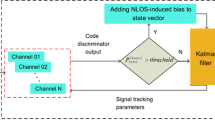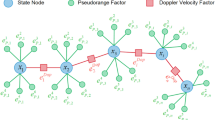Abstract
The research regarding global positioning system (GPS) vector tracking (VT), based on a software-defined receiver (SDR), has been increasing in recent years. The strengths of VT include its immunity to signal interference, its capability to mitigate multipath effects in urban areas, and its excellent performance in tracking signals under high-dynamic applications. We developed open-source MATLAB code for GPS VT SDR to enable researchers and scientists to investigate its pros and cons in various applications and under various environments. To achieve this goal, we developed an “equivalent conventional tracking (CT)” SDR as a baseline to compare with VT. The GPS positioning estimator of this equivalent CT is based on an extended Kalman filter (EKF), which has exactly the same state, system, and carrier measurement models and noise tuning method as VT. This baseline provides users with a tool to compare the performance of VT and CT on common ground. In addition, this MATLAB code is well organized and easy to use. Users can quickly implement and evaluate their own newly developed baseband signal processing algorithms related to VT. The implementation of this VT code is described in detail. Finally, static and kinematic experiments were conducted in an urban and open-sky area, respectively, to show the usage and performance of the developed open-source GPS VT SDR.









Similar content being viewed by others
References
Bhattacharyya S, Gebre-Egziabher D (2010) Development and validation of parametric models for vector tracking loops. Navig J Inst Navig 57:275–295
Borre K, Akos D, Bertelsen N, Rinder P, Jensen S (2007) A software defined GPS and Galileo receiver—a single-frequency approach. Applied and numerical harmonic analysis, Birkhäuser, Boston
Brewer J, Raquet J (2016) Differential vector phase locked loop. IEEE Trans Aerosp Electron Syst 52:1046–1055
Copps E, Geier G, Fidler W, Grundy P (1980) Optimal processing of GPS signals. Navig J Inst Navig 27:171–182
Groves P, Mather C (2010) Receiver interface requirements for deep INS/GNSS integration and vector tracking. J Navig 63:471–489
Hsu L-T, Groves P, Jan S (2013) Assessment of the multipath mitigation effect of vector tracking in an urban environment. In: Proceedings of ION Pacific PNT 2013, Honolulu, Hawaii, 22–25 April 2013, pp 498–509
Hsu L-T, Jan S, Groves P, Kubo N (2015) Multipath mitigation and NLOS detection using vector tracking in urban environments. GPS Solut 19:249–262
Hsu L-T, Gu Y, Kamijo S (2016) 3D building model-based pedestrian positioning method using GPS/GLONASS/QZSS and its reliability calculation. GPS Solut 20:413–428
Lashley M, Bevly D (2007) Analysis of discriminator based vector tracking algorithm. In: Proceedings of ION NTM 2007, San Diego, CA, 22–24 January 2007, pp 570–576
Lashley M, Bevly D (2009) Vector delay/frequency lock loop implemenation and analysis. In: Proceedings of ION ITM 2009, Anaheim, CA, 26–28 January 2009, pp 1073–1086
Lashley M, Bevly D (2013) Performance comparison of deep integration and tight coupling. Navig J Inst Navig 60:159–178
Lashley M, Bevly DM, Hung JY (2009) Performance analysis of vector tracking algorithms for weak GPS signals in high dynamics. IEEE J Sel Top Signal Process 3:661–673
Liu J, Yin H, Cui X, Lu M, Feng Z (2011) A direct position tracking loop for GNSS receivers. In: Proceedings of ION GNSS 2011, Portland, OR, 20–23 September 2011 2011. pp 3634–3643
Luo Y, Babu R, Wu W, He X (2012) Double-filter model with modified Kalman filter for baseband signal pre-processing with application to ultra-tight GPS/INS integration. GPS Solut 16:463–476
Maier D, Frankl K, Pany T (2018) The GNSS-transceiver: using vector-tracking approach to convert a GNSS receiver to a simulator: implementation and verification for signal authentication. In: Proceedings of ION GNSS + 2018, Miami, Florida, pp 4231–4244, 24–28 September 2018
Mohamed A, Schwarz K (1999) Adaptive Kalman filtering for INS/GPS. J Geodesy 73:193–203
Ng Y, Gao GX (2017) GNSS multireceiver vector tracking. IEEE Trans Aerosp Electron Syst 53:2583–2593
Pany T, Eissfeller B (2006) Use of a vector delay lock loop receiver for GNSS signal power analysis in bad signal conditions. In: Proceedings of 2006 IEEE/ION Position, Location, And Navigation Symposium, Coronado, CA, USA, 25–27 April 2006, pp 893–903
Petovello MG, Lachapelle G (2006) Comparison of vector-based software receiver implementations with application to ultra-tight GPS/INS integration. In: Proceedings of ION GNSS 2006, Fort Worth, TX, 26–29 September 2006, pp 1790–1799
Ren T, Petovello M, Basnayake C (2013) Improving GNSS bit synchronization and decoding using vector tracking. In: Proceedings of ION GNSS + 2013, Nashville, TN, 16–20 September 2013, pp 121–134
Shytermeja E, Garcia-Pena A, Julien O (2017) Dual-constellation vector tracking algorithm in ionosphere and multipath conditions. In: Proceedings of ITSNT 2017, ENAC, Toulouse, France, 14–17 Nov 2017
Spilker JJ (1996) Fundamentals of signal tracking theory. In: Parkinson BW, Spilker JJ, Axelrad P, Enge P (eds) Global positiooning system: theory and application, vol 1. Progress in astronautics and aeronautics, vol 163, 2 edn. American Institute of Aeronautics, Washington, pp 289–327
Sun Z, Wang X, Feng S, Che H, Zhang J (2017) Design of an adaptive GPS vector tracking loop with the detection and isolation of contaminated channels. GPS Solut 21:701–713
Syed Dardin S, Calmettes V, Priot B, Tourneret J-Y (2013) Design of an adaptive vector-tracking loop for reliable positioning in harsh environment. In: Proceedings of ION GNSS + 2013, Nashville, TN, 16–20 September 2013, pp 3548–3559
Tabatabaei A, Mosavi M (2017) Robust adaptive joint tracking of GNSS signal code phases in urban canyons. IET Radar Sonar Navig 11:987–993
Van Nee D, Coenen A (1991) New fast GPS code-acquisition technique using. FFT Electron Lett 27:158–160
Won J, Dötterböck D, Eissfeller B (2010) Performance comparison of different forms of Kalman filter approaches for a vector-based GNSS signal tracking loop. Navig J Inst Navig 57:185–199
Zhao S, Akos D (2011) An open source GPS/GNSS vector tracking loop - implementation, filter tuning, and results. In: Proceedings of ION ITM 2011, San Diego, CA, 24–26 January 2011, pp 1293–1305
Zhao S, Lu M, Feng Z (2011) Implementation and performance assessment of a vector tracking method based on a software GPS receiver. J Navig 64:S151–S161
Acknowledgements
The authors acknowledge the support of Hong Kong PolyU startup fund on the project 1-ZVKZ, “Navigation for Autonomous Driving Vehicle using Sensor Integration”.
Author information
Authors and Affiliations
Corresponding author
Additional information
Publisher’s Note
Springer Nature remains neutral with regard to jurisdictional claims in published maps and institutional affiliations.
The GPS Tool Box is a column dedicated to highlighting algorithms and source code utilized by GPS engineers and scientists. If you have an interesting program or software package you would like to share with our readers, please pass it along; e-mail it to us at gpstoolbox@ngs.noaa.gov. To comment on any of the source code discussed here, or to download source code, visit our website at http://www.ngs.noaa.gov/gps-toolbox. This column is edited by Stephen Hilla, National Geodetic Survey, NOAA, Silver Spring, Maryland, and Mike Craymer, Geodetic Survey Division, Natural Resources Canada, Ottawa, Ontario, Canada.
Rights and permissions
About this article
Cite this article
Xu, B., Hsu, LT. Open-source MATLAB code for GPS vector tracking on a software-defined receiver. GPS Solut 23, 46 (2019). https://doi.org/10.1007/s10291-019-0839-x
Published:
DOI: https://doi.org/10.1007/s10291-019-0839-x




